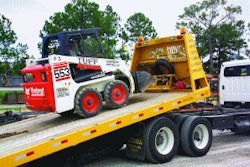
A business model is the first step in a building a successful business. Identifying and choosing a business model that can deliver bottom line profitability is essential to your business' success. The term has grown in popularity as a replacement for business strategy. Strategy implies a thorough identification of how you're going to make money. Your business model answers the question "What business are you in?"
A simple way of showing the difference between a business model and a business strategy is to consider a business plan that you might share with a bank, SBA or investor in order to secure funding. The business model would be presented in the opening paragraph of the executive summary. The business strategy would be the rest of the document.
Types of business models
As simplistic as business models are, they exert tremendous power over the evolution and success of your business. When first meeting contractors, we often discover they have unknowingly adopted a business model that is difficult to grow with. The most common flawed model is what could politely be called "The Opportunist." The opportunist model is where a contractor is willing to take on any work that comes his way regardless of who it comes from and what it involves. Most bankruptcy stories I hear have a tipping point where the contractor took on a project they had no business taking on. In other words, they had adopted the opportunist model.
Your business model must align with several items: your skills, your crews' skills, existing competition and the available market. Failure to align your model to any one of those items is a recipe for failure. Here are the business models that can be successful in commercial construction.
1. Direct to GC, new construction
2. Direct to GC, remodels
3. Direct to client, construction (outside design)
4. Direct to client, construction (design-build)
5. Direct to client, service
6. Special niche; work type
7. Special niche; client type
Hopefully they are self explanatory. The larger your company, the more of these models you can pursue. Yes, you can adopt more than one business model - but only once you have a large enough staff to handle each profitably.
Extremely large contractors, say $50 million and up, might be able to adopt all of them. Small contractors need to be very careful when considering whether to adopt multiple business models. Contractors under $5 million are almost always better off limiting themselves to no more than two models. Contractors under $2 million are almost always better off limiting themselves to one business model.
Four Steps to a Business Model that Can Work
Avoid common mistakes
In order to pursue multiple business models successfully you will need to avoid a handful of common mistakes. The first of which is the misassignment of overhead.
Years ago I worked with a large contractor who had two business models. One was extremely equipment heavy. The other wasn't. The contractor made the mistake of assigning the same overhead charge per dollar of job cost for all work. As they had buried their equipment costs in overhead (another classic mistake) their approach tended to over-cost one side of their business and under-cost the other side. The impact of this problem was that they kept taking jobs on the equipment heavy side they should have avoided and kept passing on jobs on the non-equipment side they should have pursued. If you are going to adopt multiple business models, you will often need to use different overhead charge rates.
The most common oversight made by contractors is failing to consider the depth of existing competition. Profitability is greatly impacted by price pressure right? Few things drive down prices faster than a high number of contractors available to perform the work. This is why focusing on one or two niches often works so well.
Find a niche that requires a significant amount of specialized skill and make sure the field people who have that skill stick around. Niches make marketing easier, they make selling easier, they make operations management easier, all of which leads to higher margins.
The least overlooked issue is the size of the available market. Once a contractor identifies an available market keeping track of its size is fairly easy. Usually there is a small group of A/E firms and / or specialty equipment suppliers who can be networked with to keep a finger on the market's pulse.
One factor I didn't mention, mainly because over the long haul it shouldn't prevent you from adopting a corresponding business model, is the cash flow inherent in the business model. Needless to say, certain models lend themselves to faster pay. Service work is a great example. If you pick the right model(s), run a profitable business and keep cash in the business you should be able to live with a slow pay model. One advantage of a slow pay model is that it limits competition. If you think things are bad in the GC world now, imagine how price competitive it would be if GCs paid every 30 days.
Marketing your model
Branding can become very difficult when you adopt multiple business models. The "all things to all people" marketing message creates doubt in prospects' minds. The incredible proliferation of specialists in the last 20 years has left us with the conclusion that we need a specialist with experience. It's no longer good enough to say you do drywall in commercial buildings. Now you need to say that you've down several remodel projects in operating hospitals.
Take that thought and apply it to your marketing and selling programs. How are you going to successfully convince buyers (including GCs) that you are the preferred choice for their project when you are running around claiming to be great at everything. Nobody is going to believe that pitch even if you are great at everything.
Summarizing, if you are under $2 million pick one business model and stick to it like glue until you are (a) consistently profitable, (b) growing past $2.5 million and (3) willing to implement the costing and marketing systems necessary to support two models.




















